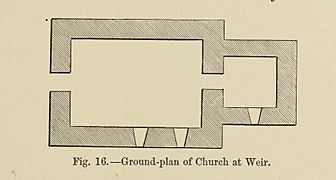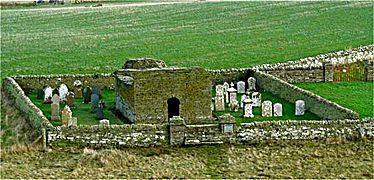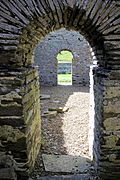St. Mary's Chapel, Wyre facts for kids
St. Mary's Chapel is an old church building on Wyre, an island in Orkney, Scotland. It was built way back in the 1100s. People believe a powerful Norse leader named Kolbeinn hrúga, or his son Bjarni Kolbeinsson, who was a bishop, built it. This church is now missing its roof. It was built in a style called Romanesque, using local stones and a special kind of cement. It was fixed up a bit in the late 1800s. Today, it's a protected historical site, including the church and its old graveyard. Historic Environment Scotland made it a scheduled monument in 1929.
Contents
About St. Mary's Chapel
St. Mary's Church is located on the northwest side of Wyre island in Orkney, Scotland. The church and its graveyard are at the bottom of a hill. At the top of this hill, you can find the old ruins of Cobbie Row's Castle. The chapel is built in the Romanesque style. It was made from local stones and a type of mortar.
What the Chapel Looks Like
This building dates back to the mid to late 1100s. It has two main parts: a rectangular nave and a chancel. The nave is the main part where people would sit. It measures about 5.87 meters long and 3.9 meters wide. The chancel is a smaller area near the altar. It is about 2.42 meters long and 2.2 meters wide.
A round-arched doorway leads into the nave. Another archway separates the nave from the chancel. There are three small windows on the south wall of the chapel. You can still see bits of the original plaster on the walls inside. The graveyard around the church has been made bigger over time. People still use it for burials today.
The Chapel's History
The chapel was built in the mid to late 1100s. It was likely built by Kolbeinn hrúga or his son, Bjarni Kolbeinsson. Kolbeinn hrúga was a Norse chieftain, a powerful leader from Norway. He moved to Orkney around the year 1142 AD.
Kolbeinn hrúga and Wyre
According to an old story called the Orkneyinga saga, Kolbeinn hrúga built a stone fort on Wyre island. This fort's ruins are now known as Cobbie Row's Castle. The fact that there was a strong stone fort and a chapel nearby shows something important. It suggests that Wyre was once a very important and wealthy Norse estate.
Later Years and Restoration
By the late 1700s, the chapel was no longer used. It had fallen into ruins. In the late 1800s, the building was cleaned up. Some parts of its walls were rebuilt. During this restoration work, something interesting was found. A grave was uncovered inside the chapel. It held the remains of a very tall and strong man.
A baptismal font, which is a basin used for baptisms, was also found. It was broken into two pieces. Later, this font was moved to Trumland House on the island of Rousay.
Protected Site
In 1929, Historic Environment Scotland officially made the site a scheduled monument. This means it is a nationally important archaeological site. The monument includes the ruins of St. Mary's Chapel and its walled cemetery.
Gallery
- St. Mary's Chapel
See also
- Eynhallow Church
- St Boniface's Church, Papa Westray
- List of churches in Orkney






